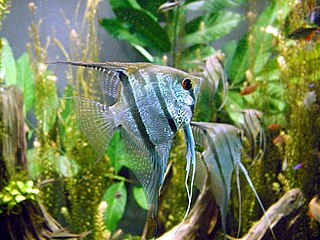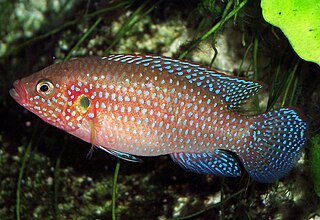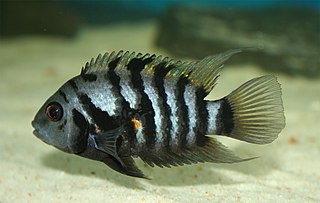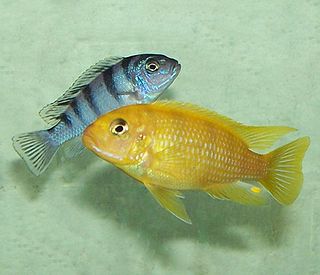
Cichlids are fish from the family Cichlidae in the order Cichliformes. Cichlids were traditionally classed in a suborder, the Labroidei, along with the wrasses (Labridae), in the order Perciformes, but molecular studies have contradicted this grouping. The closest living relative of cichlids is probably the convict blenny, and both families are classified in the 5th edition of Fishes of the World as the two families in the Cichliformes, part of the subseries Ovalentaria. This family is both large and diverse. At least 1,650 species have been scientifically described, making it one of the largest vertebrate families. New species are discovered annually, and many species remain undescribed. The actual number of species is therefore unknown, with estimates varying between 2,000 and 3,000.

The green terror is a colorful freshwater fish in the cichlid family. The fish originates from the Pacific side of South America from the Tumbes River in Peru to the Esmeraldas River in Ecuador. It is polymorphic and can have white or gold-orange edging to the tail and dorsal fins. It has historically been confused with two other species that always have narrow, clearly defined white edging, the more southerly distributed A. stalsbergi and the more northerly A. blombergi.

Hemichromis is a genus of fishes from the cichlid family, known in the aquarium trade as jewel cichlids. Jewel cichlids are native to Africa. Within West Africa, Hemichromis species are found in creeks, streams, rivers and lakes with a variety of water qualities including brackish water lagoons.

Geophagus is a genus of cichlids that mainly live in South America as far south as Argentina and Uruguay, but a single species, G. crassilabris is from Panama. They are found in a wide range of freshwater habitats. They are part of a group popularly known as eartheaters and mostly feed by picking up mouthfuls of sediment to sift out food items such as invertebrates, plant material and detritus. The largest species reach up to 28 cm (11 in) in standard length. They are often kept in aquariums.

The convict cichlid is a fish species from the family Cichlidae, native to Central America, also known as the zebra cichlid. Convict cichlids are popular aquarium fish and have also been the subject of numerous studies on fish behaviour.

Maylandia lombardoi, is a 13 centimetres (5.1 in) long freshwater fish from the family Cichlidae. This species is popular in the aquarium hobby where it is sold under a variety of common names including: lombardoi mbuna, kenyi mbuna or kennyi mbuna or kenyi cichlid. This species is sometimes seen in the genus Metriaclima owing to a dispute in which a minority of cichlid researchers do not consider Maylandia valid (see Maylandia for discussion. The specific name honours the exotic fish dealer John Lombardo.

Mayaheros urophthalmus, also known as the Mayan cichlid or Mexican mojarra is a species of cichlid.

The blue ram, Mikrogeophagus ramirezi, is a species of freshwater fish endemic to the Orinoco River basin, in the savannahs of Venezuela and Colombia in South America. The species has been examined in studies on fish behaviour and is a popular aquarium fish, traded under a variety of common names, including ram, blue ram, German blue ram, Asian ram, butterfly cichlid, Ramirez's dwarf cichlid, dwarf butterfly cichlid and Ramirezi. The species is a member of the family Cichlidae and subfamily Geophaginae.

Vieja melanurus, the quetzal cichlid, redhead cichlid or firehead cichlid, is a species of cichlid that is native to the Lake Petén system, the Grijalva–Usumacinta River basin and other Atlantic river drainages in southern Mexico, Belize and Guatemala, with introduced populations in a few other countries. It typically inhabits slow-moving or standing waters such as rivers, lakes and lagoons; although primarily a freshwater fish, it may occur in slightly brackish habitats. It is popular in the aquarium trade, where often listed under the synonym V. synspila/synspilum. It is almost entirely herbivorous, but may also take small animal prey.

Mikrogeophagus altispinosus is a species of fish endemic to the Amazon River basin in Brazil and Bolivia. The species is part of the family Cichlidae and subfamily Geophaginae. It is a popular aquarium fish, traded under the common names Bolivian butterfly, Bolivian ram, Bolivian ram cichlid, and ruby crown cichlid.

Copadichromis borleyi is a species of haplochromine cichlid fish endemic to Lake Malawi in East Africa. The species is popular in the fishkeeping hobby where it is frequently kept in aquariums. The species has numerous common names, including redfin hap and goldfin hap.

Apistogramma nijsseni is a species of cichlid fish, endemic to highly restricted local black water habitats in the Quebrada Carahuayte, a small stream in the Ucayali River drainage, southern Peru. The male reaches a maximum length of 8 cm (3 in), the female remaining somewhat smaller. Apistogramma brooding females assume a bright yellow and black aposematic coloring: in A. nijsseni, unusually, a healthy, unstressed female retains this coloring. The species is popular aquarium fish amongst dwarf cichlid hobbyists, though it does not often appear in the general pet fish market.
Astatotilapia flaviijosephi, the Jordan mouthbrooder, is a vulnerable species of freshwater fish in the family Cichlidae (cichlids). It is found in the central Jordan River system, including Lake Tiberias (Kinneret), in Israel, Jordan and Syria, making it the only haplochromine cichlid to naturally range outside of Africa. This species is too small to be of significant importance to fisheries, unlike the only other cichlids native to the Levant, the economically important tilapias.

The blue acara is a very colorful freshwater fish in the cichlid family. This fish can be found in various freshwater habitats, ranging from standing water to flowing streams, in Venezuela and Trinidad. They can reach lengths of 16 cm (6.3 in). The scientific species name is indicative to its looks; pulcher meaning "beautiful" in Latin. The blue acara is a common cichlid sold in many aquarium stores, and is sometimes confused with the larger green terror.

Iranocichla is a genus of fish in the family Cichlidae found in fresh and brackish waters in southern Iran. They are the only cichlids native to this country.
Andinoacara stalsbergi is a species of South American freshwater fish in the family Cichlidae. It was previously included in A. rivulatus, but was described as a separate species in 2009. The specific name honours the Norwegian aquarist Alf Stalsberg who collected the type of this species and who has had a “longstanding commitment to increase the knowledge about cichlid fishes”.

Hemichromis lifalili, common name blood-red jewel cichlid, is a species of fish in the family Cichlidae.

Australoheros facetus, the chameleon cichlid or chanchito, is a species of cichlid from the subfamily Cichlasomatinae which is native to northern Argentina, Paraguay, Uruguay and southern Brazil.

Iranocichla persa is a species of mouth brooding cichlid which was described in 2016 from the drainage basins of the Shur, Hasanlangi and Minab Rivers which flow into the Persian Gulf at the Strait of Hormuz in southern Iran.
Paracobitis persa is a species of stone loach found in the Mallosjsn spring and Sivand River of the Kor basin in southern Iran. This species reaches a length of 8.1 cm (3.2 in).















